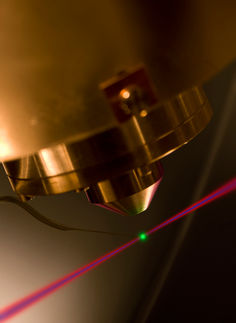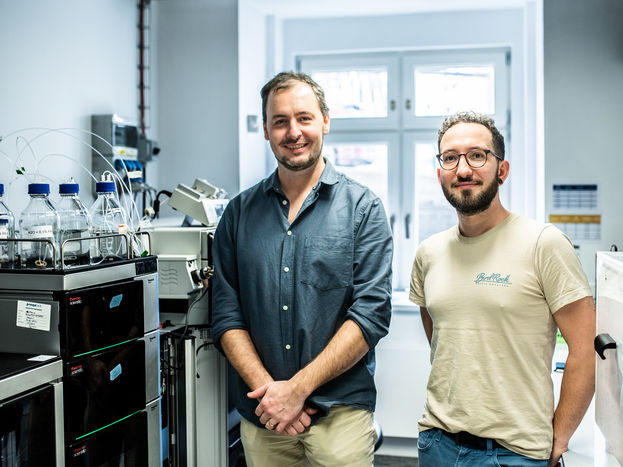How small is the proton?
International team of researchers observes unexpectedly small proton radius in a precision laser experiment with exotic hydrogen atoms
The proton - one of the universal building-blocks of all matter - is even smaller than had previously been assumed. This is the result obtained at the Paul-Scherrer-Institut (PSI) in Villigen (Switzerland) by an international research team, including scientists from the Max Planck Institute of Quantum optics (MPQ) in Garching, the Ludwig-Maximilians-Universität (LMU) Munich and the Institut für Strahlwerkzeuge (IFWS) of the Universität Stuttgart (both from Germany).
It is not yet clear how this discrepancy has to be interpreted. Ultimately, the result could question the validity of the most precisely tested fundamental theory of matter and light, or change the value of the most precisely determined fundamental physical constant. For the new high precision determination of the proton radius, the researchers made use of an ex-otic type of hydrogen atoms, formed by a negatively-charged muon orbiting around a pro-ton. Muons are very much like electrons, except they are 200 times heavier. The atomic orbit of the muon is therefore 200 times closer to the proton than the electron's orbit in a regular hydrogen atom. Hence the muon literally ‘feels’ that the proton is an extended object, and this has a detectable effect on its orbit. Using a specially developed laser and a new type of muon beam - provided by PSI - allowed the researchers to measure some features of the muon orbit, and thus determine the radius of the proton.
Protons are one of the three basic building blocks of matter: protons and neutrons form the atomic nucleus, and the nucleus is surrounded by orbiting electrons. The chemical elements are identified by the number of protons in the nucleus. Hydrogen is the simplest of all atoms. Its nucleus consists of a single proton which is orbited by a single electron. Due to its simplicity, the hydrogen atom is also seen as the ‘Rosetta stone’ of quantum physics, as it has historically often been used as the best object for the investigation of basic questions in physics. While electrons and muons are believed to be point-like particles, the proton is made from quarks and is therefore an extended object. In order to determine the proton radius, the researchers replaced the single electron in hydrogen atoms with a negatively-charged muon. Muons are very much like electrons, but they are 200 times heavier. According to the laws of quantum physics, the muon must therefore travel 200 times closer to the proton than the electron does in an ordinary hydrogen atom. In turn, this means that the characteristics of the muon orbit are much more sensitive to the dimensions of the proton. The muon ‘feels’ the size of the proton and adapts its orbit accordingly. “In fact, the extension of the proton causes a change in the so-called Lamb-shift of the energy levels in muonic hydrogen”, Dr. Randolf Pohl from the Laser Spectroscopy Division of Prof. Theodor W. Hänsch (Chair of Experimental Physics at LMU and Director at MPQ) explains. “Hence the proton radius can be deduced from a spectroscopic measurement of the Lamb shift.”
As early as in the 1970s the idea was born to determine the proton radius via high precision spec-troscopy of muonic hydrogen. However it took more than 40 years between the conception of the idea and the realization of such an experiment because many experimental challenges had to be overcome. “In order to have any chance of observing the atomic transition we had to refine several experimental components simultaneously” says Dr. Franz Kottmann from PSI, who was part of the collaboration from its very beginning. “We needed slow muons to make sure that they are stopped inside the hydrogen gas. Although we want to produce as many muonic hydrogen atoms as possi-ble, we have to work with highly diluted hydrogen gas. Otherwise the muonic hydrogen atoms are destroyed by collisions. And of course we needed a suitable fast laser system whose frequency can be adjusted in small steps.” And Prof. Thomas Graf from IFSW adds: “The specific requirements on the laser capabilities – intensive light pulses have to be fired only a few nanoseconds after a muon has been detected – were finally met by a new disk laser technology which we developed in Stuttgart.”
Finally the experiment has been realized in a joined effort in which each team brought in its own expertise in the fields of accelerator physics, atomic physics, laser technologies and detectors. First measurements in 2002, 2003 and 2007 were not encouraging. Although the experiment seemed to work as planned, there was no sign of the expected resonance. “First we thought our lasers were not good enough, so we rebuilt large parts of the laser system using the new disk laser technology developed at the University of Stuttgart. But then it turned out that we had simply looked at the wrong place: apparently the theoretical prediction of the transition frequency was wrong”, explains Dr. Aldo Antognini from PSI.
The breakthrough happened in the summer of 2009. After three months of set up time and three weeks of data taking – day and night – the scientists could unambiguously observe the signal on the evening of July 5, 2009. After a long and careful analysis of this signal, the deduced value of the proton radius is ten times more precise, 0.84184 femtometers (1 femtometer = 0.000 000 000 000 001 meter), but in strong disagreement with the international accepted value (0.8768 femtometers) deduced from previous experiments. The scientists are still discussing the possible reasons for the discrepancy. Everything is under scrutiny now: Previous high-precision measurements, complicated calculations, and maybe at some point even the world’s most precise and best-tested fundamental theory itself: quantum electrodynamics. “However, before we question the validity of QED theorists have to check their calculations”, says Dr. Pohl. A hint, which in-terpretation could be correct, may come from the new project, planned for 2012. Then, the re-searchers want to perform the same kind of experiment with muonic helium. The required muon source and lasers, says Randolf Pohl, are already available.
Original publication: Randolf Pohl et al.; „The size of the proton“; Nature, 8 July 2010
See the theme worlds for related content
Topic World Spectroscopy
Investigation with spectroscopy gives us unique insights into the composition and structure of materials. From UV-Vis spectroscopy to infrared and Raman spectroscopy to fluorescence and atomic absorption spectroscopy, spectroscopy offers us a wide range of analytical techniques to precisely characterize substances. Immerse yourself in the fascinating world of spectroscopy!

Topic World Spectroscopy
Investigation with spectroscopy gives us unique insights into the composition and structure of materials. From UV-Vis spectroscopy to infrared and Raman spectroscopy to fluorescence and atomic absorption spectroscopy, spectroscopy offers us a wide range of analytical techniques to precisely characterize substances. Immerse yourself in the fascinating world of spectroscopy!

























































